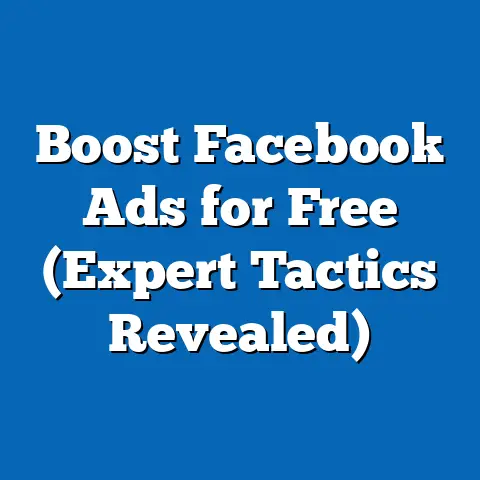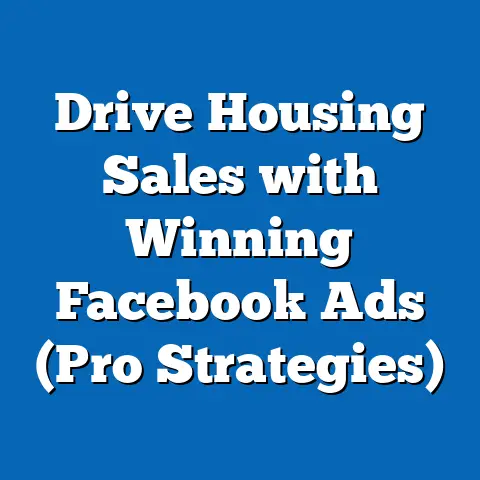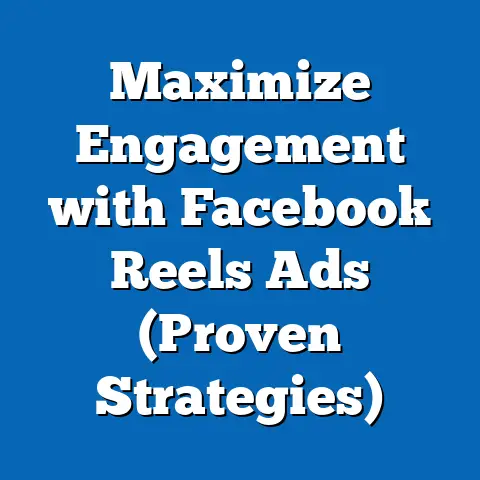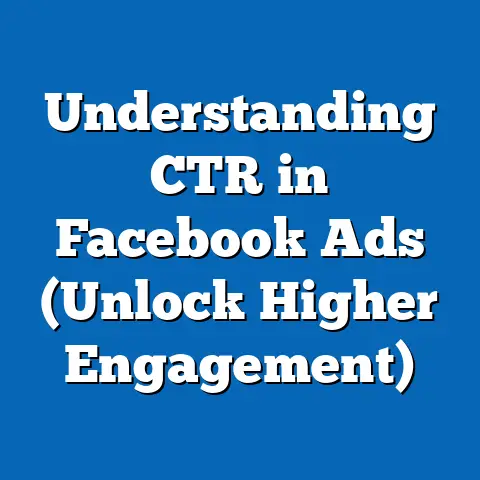Boost Facebook Ads for Tradies (Proven Strategies Inside)
In the bustling digital marketplace, first impressions are everything. For tradies (tradespeople), your Facebook ad is often the first point of contact a potential customer has with your business. It’s your virtual storefront, and just like a physical storefront, it needs to be inviting, informative, and trustworthy. I’ve seen firsthand how a poorly designed or targeted ad can send potential customers running to the competition. But, on the flip side, a well-crafted Facebook ad can be a game-changer, significantly boosting your visibility, generating leads, and ultimately, growing your business.
The trades industry is competitive. Everyone is vying for the same jobs and the same customers. A generic, uninspired Facebook ad simply won’t cut it. To stand out, you need to understand your audience, craft compelling content, utilize Facebook’s ad features strategically, and constantly measure and optimize your performance. Think of it this way: your Facebook ad is your digital handshake. Make it a good one! Studies have shown that businesses with a strong online presence experience up to 28% higher revenue growth. That’s a statistic that should get any tradie’s attention.
In this guide, I’ll walk you through proven strategies to boost your Facebook ads and attract the right customers for your trade business. I’ll share my experiences, insights, and actionable tips that you can implement today to see real results. Let’s dive in!
Section 1: Understanding Your Audience
Knowing your audience is the bedrock of any successful marketing campaign, and Facebook ads are no exception. You can’t simply throw an ad out there and hope it sticks. You need to understand who you’re trying to reach, what their needs are, and where they spend their time online. This is where creating audience personas comes into play.
Creating Audience Personas:
Think of an audience persona as a fictional representation of your ideal customer. It’s more than just demographics; it’s about understanding their motivations, pain points, and aspirations. For example, let’s say you’re a plumber specializing in residential repairs. Your ideal customer persona might look something like this:
- Name: Sarah Miller
- Age: 35-55
- Location: Suburban neighborhood in your service area
- Occupation: Homeowner, possibly with children
- Pain Points: Worried about leaky pipes, unexpected plumbing emergencies, high water bills, finding a reliable and trustworthy plumber.
- Motivations: Wants to maintain a safe and comfortable home for her family, avoid costly repairs, find a plumber who is responsive and offers transparent pricing.
By creating detailed personas like this, you can tailor your ad content to address their specific needs and concerns.
Leveraging Facebook’s Audience Insights Tool:
Facebook’s Audience Insights tool is a goldmine of information. It allows you to gather data on demographics, interests, behaviors, and even purchase habits of your target audience. To access it, navigate to your Ads Manager and look for the “Audience Insights” option.
Here’s how I use it:
- Start with a broad audience: Begin by targeting a wide geographic area and a general interest related to your trade (e.g., “home improvement,” “DIY projects,” “plumbing”).
- Analyze the data: Pay attention to the demographics (age, gender, education), interests (pages they like, topics they follow), and behaviors (purchase history, device usage) of the audience.
- Refine your targeting: Use the insights you gather to narrow down your audience and create more targeted ad sets.
For example, if you notice that a significant portion of your audience is interested in “eco-friendly home solutions,” you can incorporate that into your ad copy and target those users specifically.
Tailoring Ad Content:
The key is to make your ad content relevant and engaging to your target audience. Speak directly to their pain points and offer solutions. Use language that resonates with them and avoid jargon.
I once worked with an electrician who was struggling to generate leads. His initial ads were generic and focused on technical details that most homeowners didn’t understand. We revamped his ads to focus on the benefits of his services, such as “Protect your family with a reliable home electrical system” and “Save money on your energy bill with energy-efficient lighting.” The results were immediate; his lead generation increased by over 40%.
Takeaway: Understanding your audience is paramount. Create detailed personas, leverage Facebook’s Audience Insights tool, and tailor your ad content to resonate with their specific needs and concerns. This will significantly improve your ad performance and attract the right customers for your trade business.
Section 2: Crafting Compelling Ad Content
Now that you understand your audience, it’s time to craft ad content that grabs their attention and persuades them to take action. This involves creating catchy headlines, relatable body copy, and strong calls-to-action (CTAs), as well as using high-quality visuals.
Elements of a Successful Facebook Ad:
- Headline: Your headline is the first thing people see, so it needs to be attention-grabbing and relevant. Use strong keywords, address a pain point, or offer a solution. For example, “Emergency Plumbing Repairs? We’re Available 24/7!”
- Body Copy: Your body copy should expand on the headline and provide more details about your services. Keep it concise, easy to read, and focus on the benefits for the customer. For example, “Don’t let a leaky pipe ruin your weekend. Call us for fast, reliable plumbing repairs at affordable prices.”
- Call-to-Action (CTA): Your CTA tells people what you want them to do next. Use strong action verbs and create a sense of urgency. For example, “Get a Free Quote,” “Call Now,” “Learn More.”
- Visuals: High-quality images and videos are essential for capturing attention and building trust. Show off your work, highlight your team, or use customer testimonials.
Proven Examples of Ad Content for Tradies:
Here are a few examples of ad content that have worked well for tradies:
Visuals are crucial for building trust and credibility. People are more likely to engage with ads that feature high-quality images and videos of your work.
- Before-and-After Photos: Show the transformation you can achieve with your services. For example, a before-and-after photo of a bathroom renovation or a landscaping project.
- Customer Testimonials: Feature real customers talking about their positive experiences with your business.
- Team Photos: Show your team at work or introduce them to your audience. This helps to humanize your brand and build trust.
Tips for Enhancing Ad Effectiveness:
- Use strong action verbs in your CTAs.
- Highlight your unique selling proposition (USP). What makes you different from the competition?
- Use customer testimonials to build trust.
- A/B test different ad variations to see what works best.
- Keep your ad copy concise and easy to read.
Takeaway: Compelling ad content is the key to attracting attention and driving conversions. Use catchy headlines, relatable body copy, strong CTAs, and high-quality visuals to showcase your work and build trust with potential customers.
Section 3: Utilizing Facebook’s Ad Features
Facebook offers a wide range of ad formats and features that can be particularly beneficial for tradies. Understanding how to use these features effectively can significantly improve your ad performance and reach the right customers.
Ad Formats:
- Image Ads: Simple and effective for showcasing your work or highlighting a special offer. Use high-quality images that are relevant to your services.
- Video Ads: Engaging and informative for demonstrating your expertise or showcasing customer testimonials. Keep your videos short and to the point.
- Carousel Ads: Allow you to showcase multiple images or videos in a single ad. This is great for showcasing different services or highlighting different aspects of a project.
- Collection Ads: Designed for e-commerce but can be used to showcase a collection of services or products. This format is visually appealing and can drive traffic to your website.
Targeting Options:
- Geographic Targeting: Target customers in your local service area. This is essential for tradies who provide services in a specific geographic region.
- Interest Targeting: Target customers based on their interests and hobbies. For example, you can target people who are interested in home improvement, DIY projects, or gardening.
- Lookalike Audiences: Create audiences that are similar to your existing customers. This is a great way to reach new customers who are likely to be interested in your services.
- Custom Audiences: Upload a list of your existing customers and target them with special offers or promotions. This is a great way to re-engage with past customers and generate repeat business.
Optimizing Ad Placements and Budget Settings:
- Ad Placements: Facebook allows you to choose where your ads are displayed, such as on Facebook, Instagram, Audience Network, and Messenger. Test different placements to see which ones perform best for your business. I usually start with automatic placements, then analyze the data to see which placements are driving the best results.
- Budget Settings: You can set a daily or lifetime budget for your ad campaigns. Start with a small budget and gradually increase it as you see results. Monitor your ad performance closely and adjust your budget as needed. I recommend starting with a daily budget of $10-$20 and scaling up as you see positive ROI.
Example of Strategic Feature Use:
Let’s say you’re a landscaping company wanting to promote your spring cleanup services. Here’s how you could leverage Facebook’s features:
- Ad Format: Use a carousel ad showcasing before-and-after photos of spring cleanup projects.
- Targeting: Use geographic targeting to reach homeowners within a 20-mile radius of your business. Use interest targeting to reach people interested in gardening, landscaping, and home improvement.
- Ad Placement: Start with automatic placements, then analyze the data to see which placements are driving the best results.
- Budget: Set a daily budget of $15 and monitor your ad performance closely.
Takeaway: Facebook offers a powerful suite of ad features that can help you reach the right customers and achieve your business goals. Experiment with different ad formats, targeting options, and budget settings to find what works best for your business.
Section 4: Measuring Success and Making Adjustments
Running Facebook ads is not a “set it and forget it” endeavor. It requires constant monitoring, analysis, and optimization. You need to track your key performance indicators (KPIs) and make adjustments to your campaigns based on the data.
Key Performance Indicators (KPIs):
- Click-Through Rate (CTR): The percentage of people who see your ad and click on it. A high CTR indicates that your ad is relevant and engaging to your target audience.
- Conversion Rate: The percentage of people who click on your ad and complete a desired action, such as filling out a form, making a purchase, or calling your business. A high conversion rate indicates that your ad is effective at driving leads or sales.
- Cost Per Click (CPC): The amount you pay each time someone clicks on your ad. A low CPC indicates that your ad is cost-effective.
- Return on Ad Spend (ROAS): The amount of revenue you generate for every dollar you spend on advertising. A high ROAS indicates that your ad is profitable.
- Reach: The number of unique users who saw your ad.
- Impressions: The number of times your ad was displayed.
Using Facebook Ads Manager:
Facebook Ads Manager is your central hub for managing and analyzing your ad campaigns. It provides a wealth of data on your ad performance, including the KPIs listed above.
Here’s how I use Ads Manager:
- Check your ad performance daily: Monitor your KPIs and identify any trends or anomalies.
- Analyze your data: Look for patterns and insights that can help you improve your ad performance. For example, if you notice that your CTR is low, you may need to revamp your ad copy or visuals.
- Make adjustments: Based on your analysis, make adjustments to your ad campaigns, such as changing your targeting, ad copy, visuals, or budget settings.
A/B Testing:
A/B testing involves running two different versions of your ad simultaneously to see which one performs better. This is a great way to test different headlines, body copy, visuals, or CTAs.
Here’s how to run an A/B test:
- Create two versions of your ad: Change one element of your ad, such as the headline or the image.
- Run both ads simultaneously: Use Facebook’s A/B testing feature to run both ads to the same audience.
- Analyze the results: After a few days, analyze the results and see which ad performed better.
- Implement the winning ad: Use the winning ad in your main ad campaign.
Example of Data-Driven Adjustments:
Let’s say you’re running a Facebook ad campaign for your plumbing business and you notice that your CTR is low (0.5%). This indicates that your ad is not engaging to your target audience. You decide to run an A/B test to see if a different headline will improve your CTR.
- Ad A (Original): “Reliable Plumbing Services”
- Ad B (Test): “Emergency Plumbing Repairs? We’re Available 24/7!”
After running the A/B test for a week, you find that Ad B has a significantly higher CTR (1.5%) than Ad A. This indicates that the headline “Emergency Plumbing Repairs? We’re Available 24/7!” is more engaging to your target audience. You decide to implement Ad B in your main ad campaign.
Takeaway: Measuring success and making adjustments is crucial for optimizing your Facebook ad campaigns. Track your KPIs, use Facebook Ads Manager to analyze your data, and run A/B tests to refine your strategies based on performance data.
Conclusion
Facebook ads are a powerful tool for tradies looking to enhance their business visibility, attract new customers, and grow their business. By understanding your audience, crafting compelling ad content, utilizing Facebook’s ad features strategically, and constantly measuring and optimizing your performance, you can achieve significant results.
Remember, first impressions are everything. Your Facebook ad is often the first point of contact a potential customer has with your business. Make it a good one! Implement the proven strategies outlined in this guide and watch your Facebook ads boost your business and drive long-term success in the competitive trades market. Don’t wait, start experimenting today! Your next customer could be just a click away.





